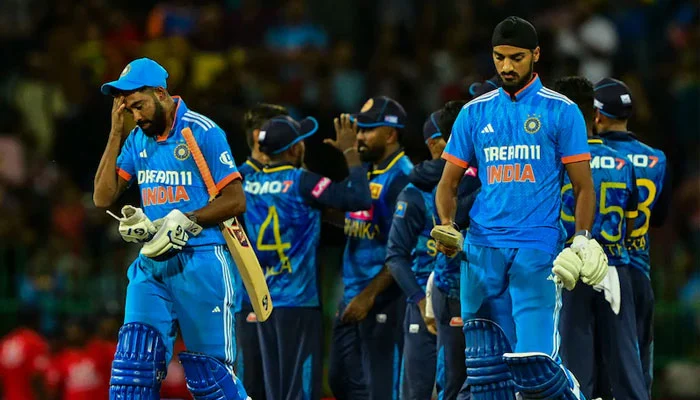In a remarkable turn of events, Sri Lanka clinched their first One Day International (ODI) series victory against India since 1997, marking a significant milestone in their cricketing history. The Sri Lankan team outclassed India by 110 runs in the decisive third ODI in Colombo, sealing the series 2-0 after the first match ended in a tie and the second match saw Sri Lanka win by 32 runs. This article delves into the key moments and standout performances that defined this historic series.

Series Overview: Breaking Down the Matches
The three-match ODI series was a testament to Sri Lanka’s resurgence in the cricketing arena, as they showcased skillful batting and formidable bowling performances. Let’s take a closer look at each match:
Match 1: A Tense Tie
The series opener was a thrilling encounter that ended in a tie, setting the stage for a competitive series. Both teams fought hard, but neither could claim victory, highlighting the evenly matched nature of the contest.
Match 2: Sri Lanka Takes the Lead
In the second ODI, Sri Lanka managed to edge out India with a narrow 32-run win. Their victory was bolstered by disciplined bowling and strategic field placements, which effectively restricted the Indian batting lineup.
Match 3: Decisive Victory for Sri Lanka
The third and final match was the most decisive, with Sri Lanka delivering a comprehensive performance to outplay India. Batting first, the hosts set a competitive target of 249 runs, and their bowlers executed a flawless plan to bowl out India for a mere 138 runs.
Key Performances: Heroes of the Series
Sri Lankan Batting Prowess
- Pathum Nissanka and Avishka Fernando: The opening pair laid a solid foundation with a partnership of 89 runs in 19.4 overs. Nissanka contributed 45 runs off 65 balls, while Fernando narrowly missed a century, scoring 95 off 102 deliveries. Their performances were pivotal in setting the tone for Sri Lanka’s innings.
- Kusal Mendis: Mendis played a crucial role in maintaining the momentum after the openers departed, scoring a valuable 59 runs. His experience and calm demeanor at the crease were instrumental in building a formidable total.
- Kamindu Mendis: Adding 23 runs towards the end of the innings, Kamindu ensured that Sri Lanka reached a competitive score, giving their bowlers enough runs to defend.
Sri Lankan Bowling Dominance
- Dunith Wellalage: The young spinner emerged as the star of the series, claiming a sensational five-wicket haul in the third ODI. His ability to extract turn and bounce from the pitch baffled the Indian batsmen, leading to their downfall.
- Jeffrey Vandersay: Complementing Wellalage’s efforts, Vandersay took two crucial wickets, breaking the backbone of India’s middle order and preventing any chance of a recovery.
Indian Batting Collapse: A Story of Struggle
India’s batting lineup, known for its firepower, faltered in the face of Sri Lanka’s disciplined bowling attack. Here’s a breakdown of India’s innings:
- Rohit Sharma: The Indian captain was the top scorer for his team, making a brisk 35 off 20 balls. His early dismissal, however, left a void that his teammates struggled to fill.
- Virat Kohli: Kohli, a veteran of many battles, failed to convert his start into a substantial innings, falling for 20 runs off 18 balls. His wicket marked the beginning of India’s middle-order collapse.
- Middle Order Woes: The likes of Rishabh Pant, Shreyas Iyer, and Axar Patel failed to make an impact, scoring 6, 8, and 2 runs respectively. Their inability to counter Sri Lanka’s spin attack proved costly for India.
- Washington Sundar: Sundar’s late resistance with a score of 30 off 25 balls was the only notable effort in India’s lower order. His innings offered a glimmer of hope but was insufficient to avert defeat.
Sri Lanka’s Tactical Mastery: Strategy and Execution
Sri Lanka’s success in the series can be attributed to their strategic planning and flawless execution on the field. Several factors contributed to their historic win:
- Spin Strategy: Sri Lanka’s spinners, led by Wellalage and Vandersay, exploited the conditions to their advantage. Their ability to maintain tight lines and vary their pace kept the Indian batsmen on the back foot.
- Field Placements: The strategic placement of fielders, particularly during the middle overs, curtailed India’s scoring opportunities and forced errors from the batsmen.
- Team Morale and Unity: The Sri Lankan team exhibited strong morale and unity throughout the series. Their collective effort and determination to end the 26-year wait for a series win against India were evident in their performance.
Looking Ahead: Implications and Future Prospects
For Sri Lanka
- Renewed Confidence: This series victory will undoubtedly boost Sri Lanka’s confidence as they prepare for future challenges. It signals their potential to compete against top-tier teams and strive for consistency in their performances.
- Building on Success: Sri Lanka’s focus will now be on building on this success and developing a team capable of delivering consistently in international cricket. Nurturing young talents like Wellalage will be crucial to their long-term success.
For India
- Addressing Vulnerabilities: India will need to address the vulnerabilities exposed during the series, particularly against quality spin bowling. Analyzing these weaknesses and working on solutions will be essential for future success.
- Leadership and Strategy: The series also highlights the need for strategic adjustments and leadership reassessment. With the World Cup on the horizon, India will aim to regroup and refocus on their strengths.
FAQs
When was the last time Sri Lanka won an ODI series against India?
The last time Sri Lanka won an ODI series against India was in 1997.
Who were the standout performers for Sri Lanka in the series?
Key performers included Avishka Fernando, Pathum Nissanka, Kusal Mendis in batting, and Dunith Wellalage and Jeffrey Vandersay in bowling.
How did India’s batting lineup perform in the series?
India’s batting lineup struggled against Sri Lanka’s disciplined bowling attack, with key players failing to make significant contributions.
What strategic factors contributed to Sri Lanka’s success?
Sri Lanka’s success was attributed to their effective use of spin bowling, strategic field placements, and strong team morale.
What are the future prospects for both teams following the series?
Sri Lanka aims to build on their success and develop consistency, while India focuses on addressing vulnerabilities and preparing for upcoming tournaments.
Conclusion
Sri Lanka’s historic ODI series win against India is a testament to their resilience and growth as a cricketing nation. This achievement not only breaks a long-standing drought but also serves as a reminder of the unpredictable and competitive nature of international cricket. As both teams look to the future, the lessons learned from this series will undoubtedly shape their strategies and performances in upcoming tournaments. The stage is set for exciting times ahead in the world of cricket.







